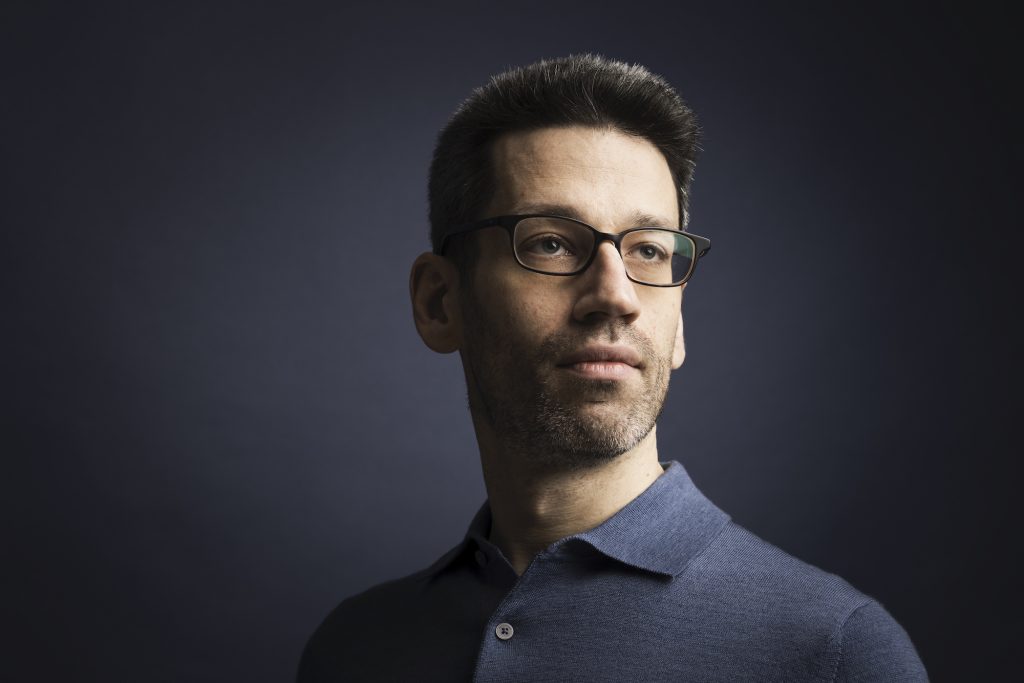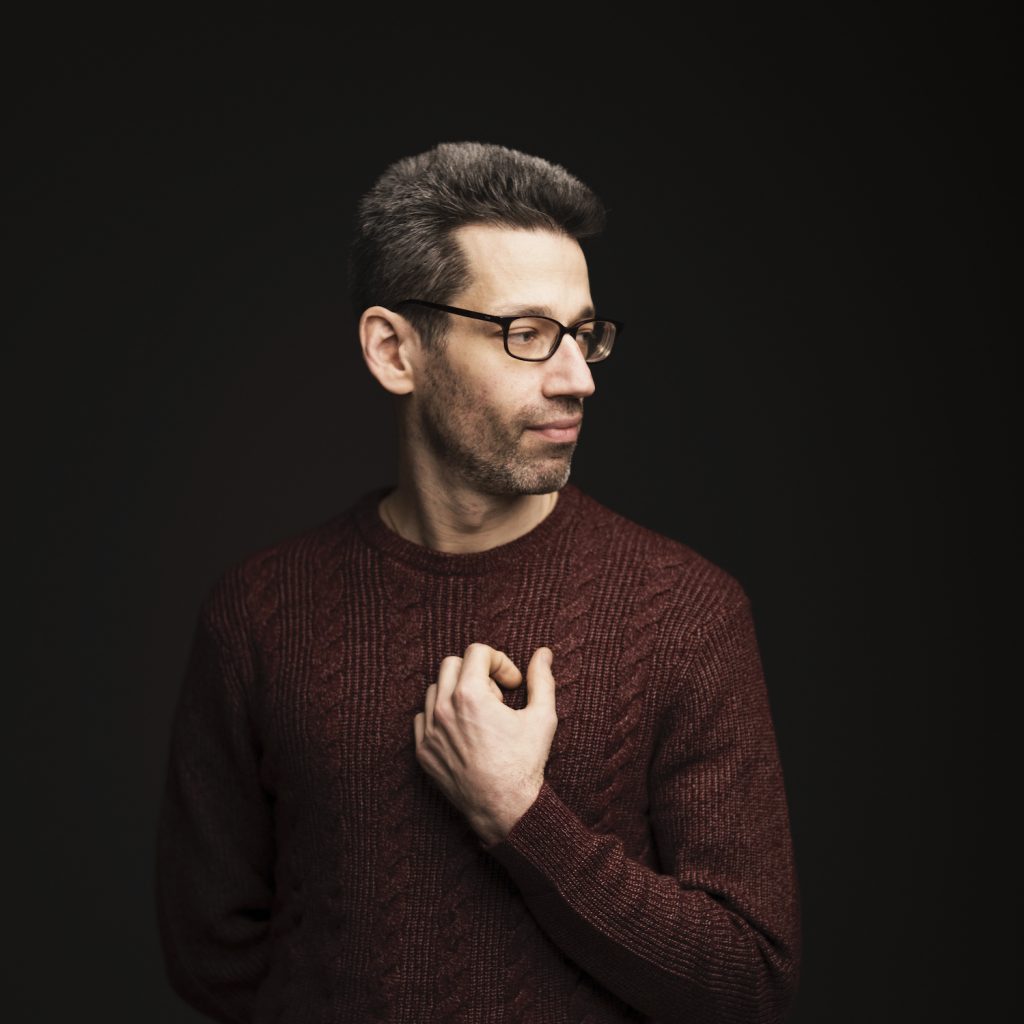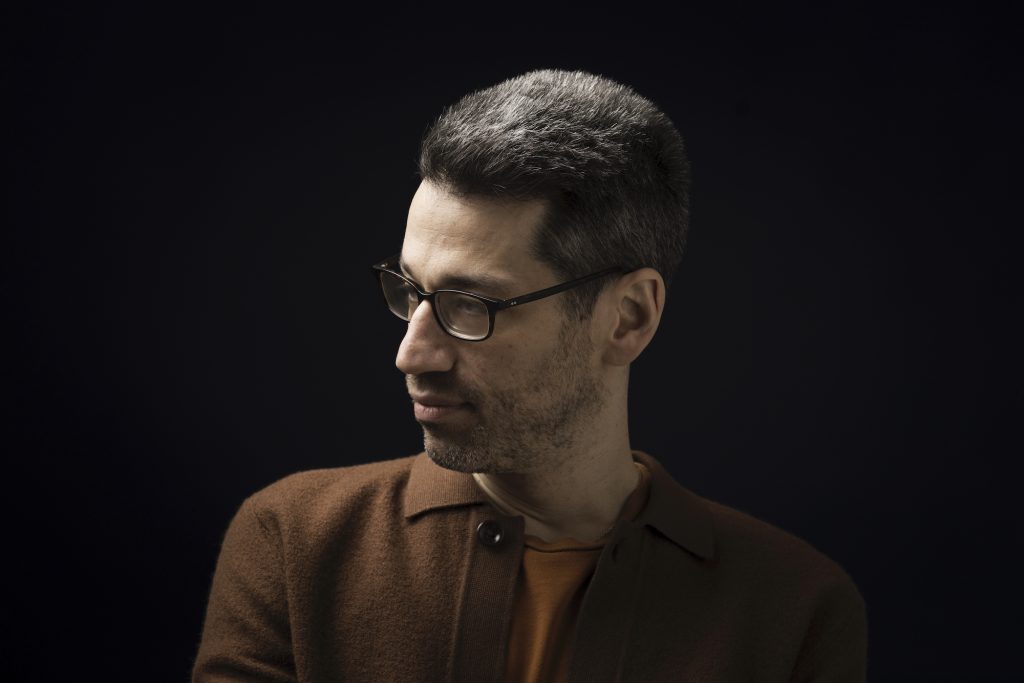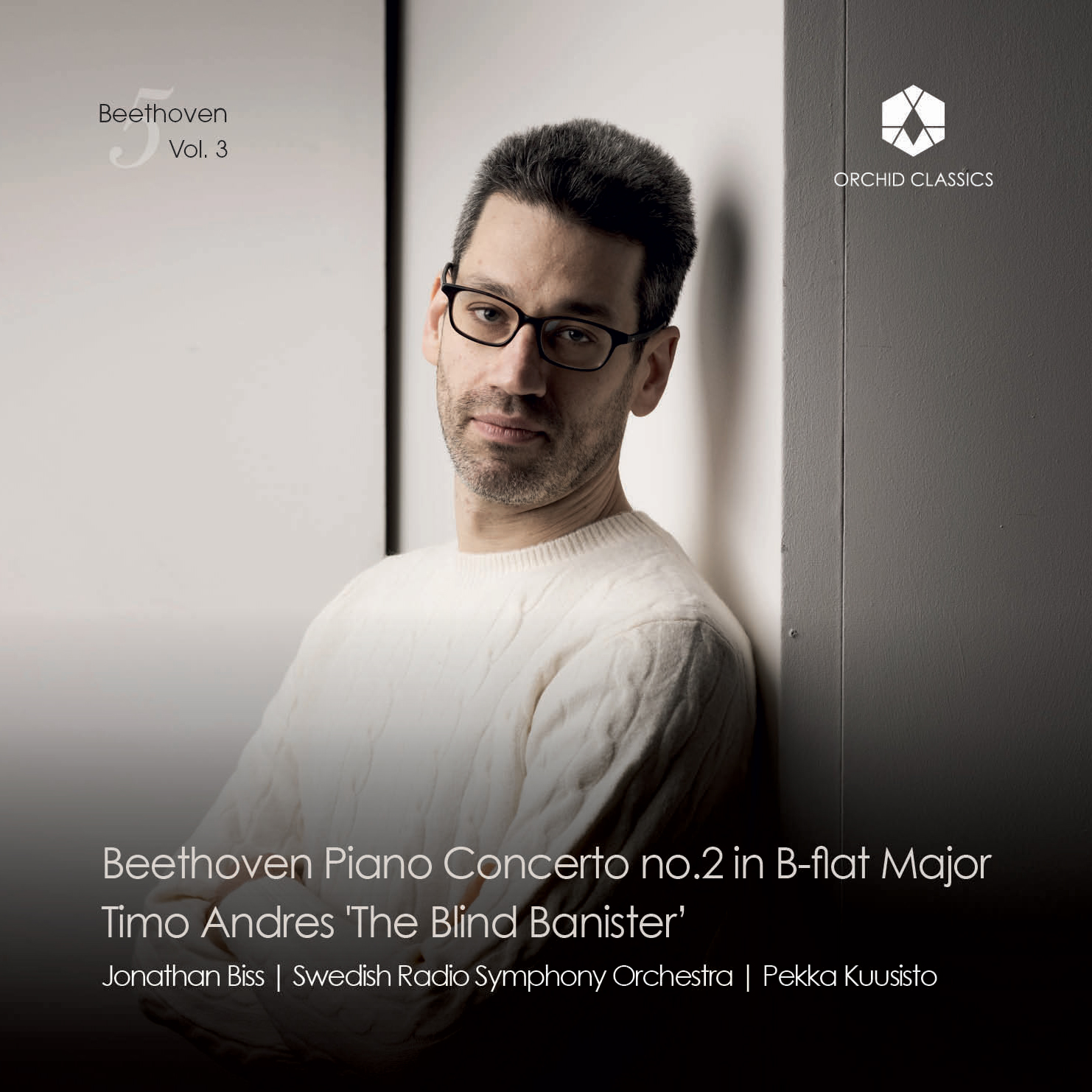Press Release
For press enquiries please contact alex.patel@orchidclassics.com. Tel: +44 7717 663481



BEETHOVEN/5 VOL. 3
Ludwig van Beethoven (1770-1827)
Piano Concerto No.2 in B-flat Major, Op.19
1. I Allegro con brio
2. II Adagio
3. III Rondo: Allegro molto
Timo Andres (b.1985)
The Blind Banister
4. I Sliding Scale
5. II Ringing Weights – III Coda. Teneramente
Jonathan Biss, piano
Swedish Radio Symphony Orchestra
Pekka Kuusisto, conductor
Jonathan Biss on Beethoven’s Piano Concerto No.2
Beethoven was not a prodigy. This was as much a question of temperament as of ability. Mozart and Mendelssohn, who produced works of inexplicable sophistication as teenagers, were not blessed or cursed with Beethoven’s dogged vision. For them, publishing music that was perfectly wrought but less than fully individual or emotionally developed was fine; for Beethoven, it would have been unthinkable. Until he had honed not just his craft, but his voice, the world would not be hearing from him.
Therefore, the Piano Concerto in B flat Major, Op. 19 is not just a great work – characterful, idiomatic, spiritual – but a fascinating historical document. While obviously not one of Beethoven’s first published works, it is among the only ones whose roots predate his twentieth birthday. (By that age, Mozart had written some 250 works that ended up in his official catalogue; Mendelssohn had produced masterpieces such as the Octet and the incidental music to A Midsummer Night’s Dream.) Beethoven completed and premiered the B flat Major Concerto in 1795, when he was twenty-four, and for the most part, it has the depth and the conviction that are among his essential qualities. Just occasionally, though, a slightly anonymous quality peeks through, evidence of the work’s early origins.
This is primarily the case in the first movement, most of all in its opening moments: a B flat major fanfare, played by the full (Mozart-sized) orchestra, then a dolce response in the strings. Neither idea is especially distinctive; both are immediately repeated, forming an eight-bar phrase that is harmonically symmetrical and rhythmically unvaried.
But while the elements themselves might be a bit all-purpose, this is still Beethoven doing the purposing and repurposing, and before long, we are fully absorbed into his world. The fanfare, rather perfunctory when it first appears, soon acquires a burbling potential energy, and then sharp elbows, giving the music specificity and inner intensity. As for the dolce response, its second appearance, mid-tutti, takes it from pleasant to wondrous: now in an otherworldly D flat Major, it is reimagined as a dialogue between the violins, each entreaty from the seconds answered by the firsts with a different sort of motivic complication. This music has both strength and vulnerability; it is pure Beethoven.
As the first movement proceeds, strength and vulnerability are not the only notable qualities: this music is also highly subtle. Each detail – the slight changes as a motive appears and then reappears, the use of harmony to alter the music’s emotional color – is sophisticated and meaningful. While the personality of this music is unmistakably Beethoven’s, the frequent, quicksilver shifts of character are reminiscent of Mozart, whose theatrical nature found magnificent expression in his piano concerti. Those works are clearly Beethoven’s model here, though he couldn’t suppress his own very different nature if he tried – which, on account of the belligerence of that nature, he never would have.
In an offhanded comment to his publisher, Beethoven dismissed this concerto (along with the one in C Major known as number 1) as “not my best.” Composers are notorious for being poor judges of their own work, but in this case, it seems probable that Beethoven didn’t even mean it – or, if he did mean it at the time, he later reconsidered it. Years after writing the concerto, he wrote a new cadenza for it, the only one to be published. That he composed a new cadenza for himself to play is not in itself meaningful; that he wrote it down and approved it for publication demonstrated that he cared enough about the concerto that he wanted to exercise some degree of control over its future performances.
This cadenza is remarkable. If snippets of the first movement offer a glimpse of Beethoven’s adolescent past, the cadenza is a window into his extraordinary future. The work’s opening fanfare is the launching pad for a series of increasingly compelling and confronting adventures. The first of these is a fugue which, thorny as it is, at least does use that motive as its subject. But as this cadenza progresses, it evolves away from the piece, acquiring a visionary quality and an air of extreme mystery, sharing little with the movement proper, save for the dotted rhythm of its opening measures. Moments before it comes to an end, the music reaches a diminished chord and simply stops, the silence asking an unanswerable question. When a series of onrushing scales brings the cadenza to a close, and the movement’s coda returns us to the world of 1795, it is jarring: the cadenza might only have been written a decade later, but it seems to exist outside the time-space continuum entirely.
Suspending time is one of Beethoven’s greatest gifts, and it again finds magnificent expression in the B flat Concerto’s middle movement. This movement gives the lie to the notion that Beethoven’s spirituality belongs specifically to his late period. Beethoven’s language evolved greatly, as that wild cadenza demonstrated, but his personality and core concerns remained remarkably consistent throughout his life. Unlike the first movement, no phrase or aspect of this music evokes Mozart. Mozart’s slow movements are operatic scenes, the Countess enumerating her regrets, Figaro and Susanna experiencing every one of love’s exhilarations and regrets. Beethoven’s slow movements are not love stories; they do not involve characters. They are conversations with the cosmos, expressions of idealism and of an unshakable belief in beauty. The opening phrase of this slow movement asks a question – not of a lost love, but of the universe. Philosophical from its first measures, as it progresses this movement grows indescribably profound. Its final pages, a gloriously unhurried colloquy between the piano and the orchestra’s strings, could make a believer of the most committed atheist.
The last movement finds Beethoven scampering back to earth. As delightfully profane as the slow movement is sacred, it has at least one eyebrow raised for all its brief duration. Beethoven’s spiritual side is balanced – and made more moving – by his earthy sense of humor, on full display here. The movement, at its core, is an essay on rhythmic displacement: the joke is that the emphases are all in the wrong places. If that seems unsophisticated, that’s because it is: the silliness is the point. The ability of this deepest of people to delight in something so basic is critical to his music’s irresistible pull. Whatever else Beethoven is, he is utterly human.
He is also an excellent prankster. Towards the end of the piece, the finale’s joke takes a twist. Beethoven transposes the theme into a remote key, and simultaneously tweaks it rhythmically, so that the stresses are finally where they really should be, by logic. By now, though, the other version is so steeped in our ear, what ought to be right sounds peculiarly wrong. Beethoven is messing with us, and enjoying himself enormously in the process.
The B flat Major Piano Concerto has often been overlooked – by historians and by concertgoers – in favor of the grandeur and formal innovations of the works that followed it. This is understandable, and a shame: its rewards are deep and grow with each listening. In short, it is a treasure.
______________________________
Timo Andres on The Blind Banister
Solo piano introduces the main theme of The Blind Banister: two descending scales, one the melody and the other (lagging behind) the accompaniment, creating little rubbing major-second suspensions against each other with every move. This “Sliding Scale” is presented over and over, forming the basis for movement of continuous variations, constantly revising themselves. Orchestral layers pile up around the scale, building dissonant towers out of those major seconds. One last, long downward scale gathers enough momentum to launch the second movement scherzo, “Ringing Weights”.
Here, the downward scale is transformed into a propulsive motor in solo strings, driving bright cascades of chromatic chords in the solo part. This movement is also made from varying modules, each increasingly elaborate—though this time, each successive module descends a step, the scale theme subverting the structure of the piece, trying to push it inexorably downwards.
The piano works hard to reverse this process in a trio section, trading a stumbling, stepwise melody with gentle orchestral echoes of the ringing chords from the scherzo. As the piano music lurches to its feet, it grows progressively more boisterous, and the steps move faster, whirling themselves into a return of the scherzo material, this time with full orchestra, the main theme in pounding timpani.
Orchestra suddenly falls away, leaving the pianist to wrestle with the two basic elements of the piece—rising and falling. Arpeggios leap up and over each other, unbound from any meter, vaulting through the harmonic atmosphere before plunging down to the lowest E. As the arpeggios begin to trace more regular patterns, the orchestra drifts back in with another long scale, descending step by step, introducing a richly harmonized Coda, really a super-compressed recapitulation of the first movement, before the piano finally rushes off into an ambiguous future.
The Blind Banister was written for and dedicated to pianist Jonathan Biss. Jonathan had asked me to compose a new concerto to be programmed alongside Beethoven’s second—a tall order. Beethoven gave this early concerto a kind of renovation in the form of a new cadenza, 20 years after writing it (around the time he was working on the Emperor concerto). It’s wonderfully jarring, in that he makes no concessions to his earlier style; for a couple of minutes, we’re plucked from a world of conventional gestures into a future-world of obsessive fugues and spiraling modulations. Like any good cadenza, it’s made from the same simple gestures which comprise the rest of the piece—an arpeggiated triad, a sequence of downward scales—but uses them as the basis for a miniature fantasia.
The Blind Banister is, in a sense, a whole piece built over this fault line in the Beethoven, trying to peer into the gap. I tried as much as possible to start with those same extremely simple elements Beethoven uses; however, my piece is not a pastiche or an exercise in palimpsest. It doesn’t quote or reference Beethoven. There are some surface similarities to his concerto (a three-movement structure, a B–flat tonal center) but these are mostly red herrings. The best way I can describe my approach to writing the piece is: I started writing my own cadenza to Beethoven’s concerto, and ended up devouring it from the inside out.
The piece was a finalist for the 2016 Pulitzer Prize.
In 2015, pianist Jonathan Biss initiated the Beethoven/5 commissioning project with The Saint Paul Chamber Orchestra and more than fifteen other orchestras, resulting in a groundbreaking collaboration over nine years. The project yielded five extraordinary new piano works by some of today’s most significant composers, responding to Beethoven’s own concerti.
Volume Three sees Timo Andres’s third piano concerto, which takes its title from “Schubertiana,” by the Swedish poet Tomas Transtromer, and envisions a “blind banister that finds its way in the darkness.” As his banister, Timo Andres seizes on the cadenza Beethoven wrote for the first movement of the Second Concerto. Beethoven pulled out all the harmonic and contrapuntal stops, and Timo Andres chose to carry that exploration a couple of centuries forward.
Jonathan Biss explains: ‘While there are no direct quotations in it, the piece is based on certain ideas Timo Andres has about the way in which Beethoven’s cadenza corresponds to his piece, and the way in which their different languages come together.’
The Blind Banister was a 2016 Pulitzer Prize finalist, and was subsequently performed by the New York Philharmonic in April 2017.
Jonathan Biss
Piano
Pianist Jonathan Biss is recognized globally for his “impeccable taste and a formidable technique” (The New Yorker). Praised by The Boston Globe as “an eloquent and insightful music writer,” Biss published his fourth book, Unquiet: My Life with Beethoven, in 2020. The book was the first Audible Original by a classical musician and one of Audible’s top audiobooks of the year.
Biss has appeared as a soloist with some of the world’s foremost orchestras, including the Los Angeles and New York Philharmonics, the Boston Symphony, the Royal Concertgebouw, the London Symphony and more. He has served as the Co-Artistic Director of the Marlboro Music School and Festival alongside pianist Mitsuko Uchida since 2018. He served on the faculty of the Curtis Institute of Music for ten years, and has been a guest professor at schools such as the Guildhall SOMAD and the New England Conservatory of Music. Biss is also the author of Unquiet: My Life with Beethoven, in which he examines music and his own life’s journey through the lens of Beethoven’s last piano sonatas.
Coinciding with the 250th anniversary of Beethoven’s birth in 2020, Biss recorded the composer’s complete piano sonatas, and offered insights to all 32-landmark works via his free, online Coursera lecture series Exploring Beethoven’s Piano Sonatas. In March 2020, Biss gave a virtual recital presented by 92NY, wherein he performed Beethoven’s last three piano sonatas for an online audience of more than 280,000 people. In 2024, Biss participated in Princeton University Concert’s Healing Through Music Series, appearing alongside author Adam Haslett for a panel discussion on anxiety, depression, and creativity. Biss is the recipient of numerous honors, including the Leonard Bernstein Award, the Andrew Wolf Memorial Chamber Music Award, an Avery Fisher Career Grant, the Borletti-Buitoni Trust Award, and a Gilmore Young Artist Award. His albums for EMI won the Diapason d’Or de l’Année and Edison awards. He was an artist-in-residence on American Public Media’s Performance Today and was the first American chosen to participate in the BBC’s New Generation Artist program.
Biss is a third-generation professional musician; his grandmother is Raya Garbousova, one of the first famous female cellists (for whom Samuel Barber composed his Cello Concerto), and his parents are violinist Miriam Fried and violist/violinist Paul Biss. Growing up surrounded by music, Biss began his piano studies at age six, with his first musical collaborations alongside his mother and father. He studied with Evelyne Brancart at Indiana University and Leon Fleisher at the Curtis Institute of Music.
Swedish Radio Symphony Orchestra
More than 100 exceptional musicians make up the Swedish Radio Symphony Orchestra, a multiple-award-winning ensemble renowned for its high artistic standard and stylistic breadth. The first radio orchestra was founded in 1925, coinciding with Sweden’s first national radio broadcasts.
Daniel Harding has been Music Director of the SRSO since 2007, with 2019 seeing him appointed as the orchestra’s first ever Artistic Director. His extensive tenure will last throughout the 2024/25 season. “It is increasingly rare for the relationship between a conductor and an orchestra not only to last for more than a decade, but to keep growing,” Harding says about working with the orchestra, “it is also rare for an orchestra of the highest musical standard to also very obviously want to keep on growing.”
The orchestra tours regularly, receiving invitations from all over Europe and the world. Recent highlights include two programmes at the Musikverein in Vienna, with programmes including Robert Schumann’s Manfred performed with the Wiener Singverein and actor Cornelius Obonya, and Schumann’s Violin Concerto with Christian Tetzlaff. Additionally, Harding and the SRSO performed an all-Sibelius programme at the Sibelius Festival in Lahti, Finland, featuring María Dueñas in Sibelius’ Violin Concerto.
Upcoming projects include playing major works by Mahler, Strauss, Alfvén and Mozart together with Christian Gerhaher and Maria João Pires, both regular musical partners of Harding and the orchestra. Venues include the Elbphilharmonie, Concertgebouw, KKL Luzern, Philharmonie de Paris and Müpa Budapest.
The SRSO remains a cornerstone of Swedish public service broadcasting, its concerts heard weekly on the classical radio P2 and regularly on Swedish national public television SVT. During the pandemic, its much appreciated on-demand streamed concerts on Berwaldhallen Play brought further worldwide attention to the orchestra.
The Swedish Radio Symphony Orchestra has an extensive and acclaimed recording catalogue. Recent releases include Jesper Nordin’s triptych Röster for orchestra, works by Britten featuring Andrew Staples and the orchestra’s own solo hornist Chris Parkes, and Eduard Tubin’s Double Bass Concerto with the orchestra’s solo bassist Rick Stotijn. Music Director Daniel Harding’s other recent, noteworthy recordings with the SRSO include Schönberg’s Verklärte Nacht and Violin Concerto with Isabelle Faust, Brahms’ Ein deutsches Requiem featuring Christiane Karg and Matthias Goerne, and Mahler’s Symphony No. 5.
Two of the SRSO’s former chief conductors, Herbert Blomstedt and Esa-Pekka Salonen, have since been named Conductors Laureate and make regular appearances with the orchestra.
Pekka Kuusisto
Conductor
Violinist, conductor, and composer Pekka Kuusisto is renowned for his artistic freedom and fresh approach to repertoire. Kuusisto is Artistic Director of Norwegian Chamber Orchestra, Principal Guest Conductor & Artistic Co-Director of Helsinki Philharmonic Orchestra and Principal Guest Conductor of the Gothenburg Symphony from season 2025/26. He is also Artistic Best Friend of Die Deutsche Kammerphilharmonie Bremen.
As an enthusiastic advocate of contemporary music and a gifted improviser, he regularly engages with people across the artistic spectrum. Uninhibited by conventional genre boundaries and noted for his innovative programming, recent projects have included collaborations with Hauschka and Kosminen, Dutch neurologist Erik Scherder, pioneer of electronic music Brian Crabtree, eminent jazz-trumpeter Arve Henriksen, juggler Jay Gilligan, accordionist Dermot Dunne and folk artist Sam Amidon.
Kuusisto regularly appears with orchestras such as Mahler Chamber Orchestra, Leipzig Gewandhaus Orchester, Berliner Philharmoniker, San Francisco Symphony, The Cleveland Orchestra, Los Angeles Philharmonic, NHK Symphony Orchestra Tokyo, Cincinnati and Boston Symphony and Tokyo Metropolitan Symphony Orchestra.
Equally active in studio, Kuusisto was featured in two releases on Sony – Bryce Dessner’s album SOLOS where he performed composer’s Ornament and Crime for solo violin, and on Anna Clyne’s and The Knights album Shorthand performing Prince of Clouds for two violins. In 2023, Kuusisto’s releases included an album for BIS on which he features as conductor of Helsinki Philharmonic Orchestra performing the first recording of Jaakko Kuusisto’s Symphony, Op.39, and another for Alba as violinist with Malin Broman and Ostrobothnian Chamber Orchestra performing works by Tarrodi, Byström, Larsson and Zinovjev. In 2022, Kuusisto released his first album as conductor, partnering with Vilde Frang and Die Deutsche Kammerphilharmonie Bremen, presenting the Stravinsky and Beethoven Concerti for Warner (for which he was nominated in the concerto category of the 2023 Gramophone Awards) and as soloist performing the world premiere recording of Ades’ Märchentänze for violin and orchestra with Nicholas Collon and Finnish Radio Symphony Orchestra for Ondine.
Timo Andres
Composer
Timo Andres (b. 1985, Palo Alto, CA) is a composer and pianist who grew up in rural Connecticut and lives in Brooklyn, NY. Recent highlights have included a solo recital debut for Carnegie Hall and the world premiere of a piano concerto for Aaron Diehl at the Los Angeles Philharmonic, led by John Adams. Andres’s orchestrations and arrangements were featured in Justin Peck’s 2024 production of Sufjan Stevens’s Illinoise completed an acclaimed limited run on Broadway at the St. James Theater; Timo received a Tony Nomination for his work.
Timo Andres is a trusted collaborator of Philip Glass, serving as advisor and editor of a 2023 edition of the Etudes published by Artisan. Andres has performed the Etudes at Lincoln Center, the Chicago Humanities Festival, the Music Academy of the West, for NPR’s Tiny Desk Concerts and elsewhere.
Notable works include Everything Happens So Much for the Boston Symphony; Strong Language for the Takács Quartet, commissioned by Carnegie Hall and the Shriver Hall Concert Series; Steady Hand, a two-piano concerto commissioned by the Britten Sinfonia premiered at the Barbican by Andres and David Kaplan; and The Blind Banister, a concerto for Jonathan Biss, which was a 2016 Pulitzer Prize Finalist.
A Nonesuch Records artist, Andres has released a series of acclaimed albums on the label; his most recent release was named on Best of 2024 lists from The New York Times, Gramophone, and NPR. In January 2025, he was announced as winner of Chamber Music Society of Lincoln Center’s Elise. L. Stoeger Prize.
A Yale School of Music graduate, he is a Yamaha/Bösendorfer Artist and is on the composition faculty at the Mannes School of Music at the New School.

Click the button above to download all album assets.

